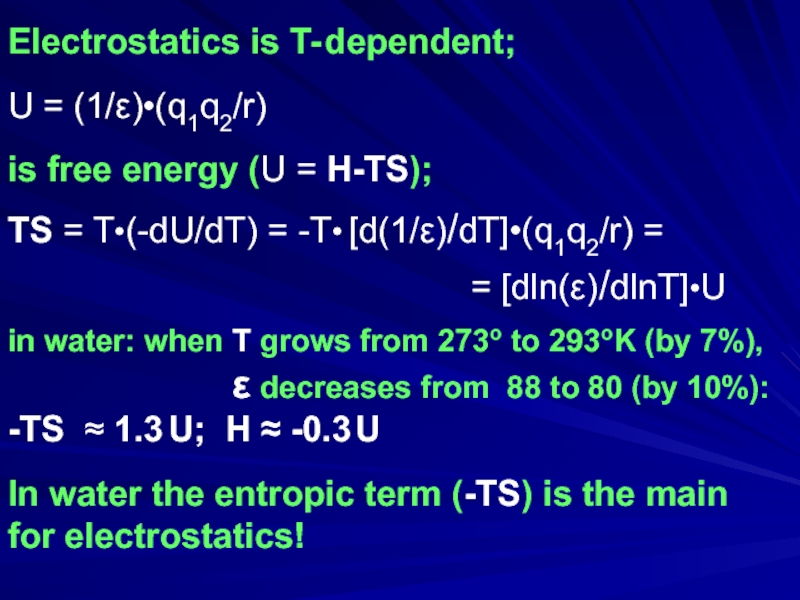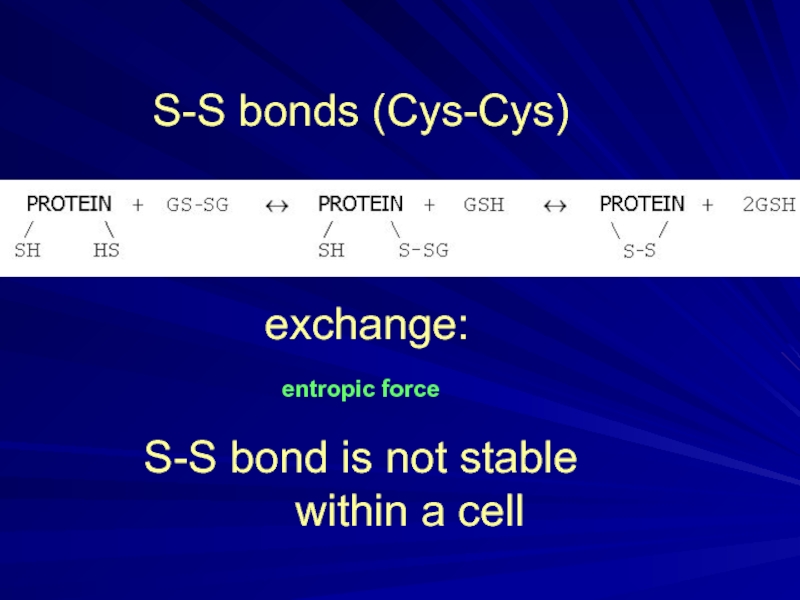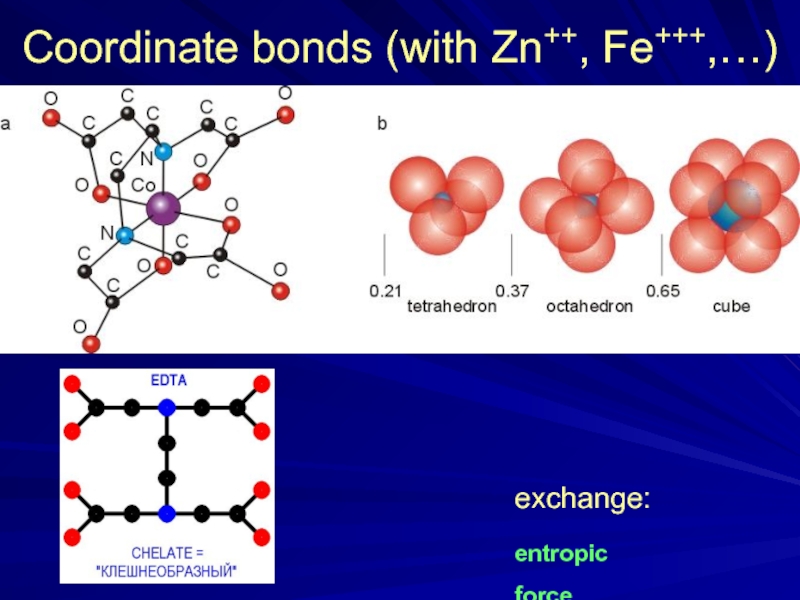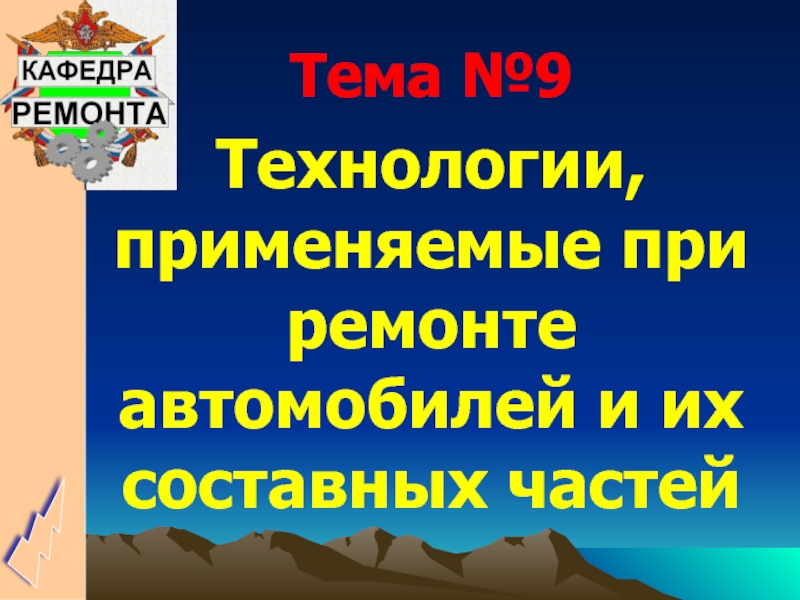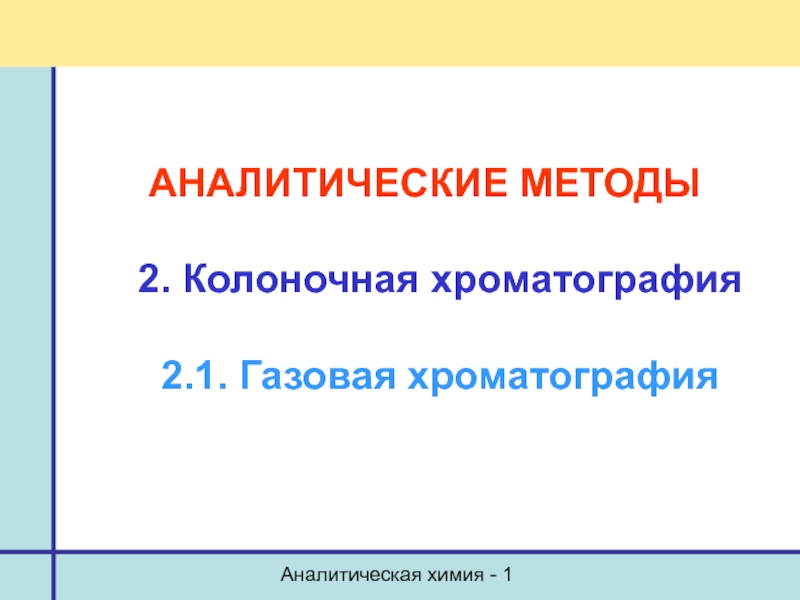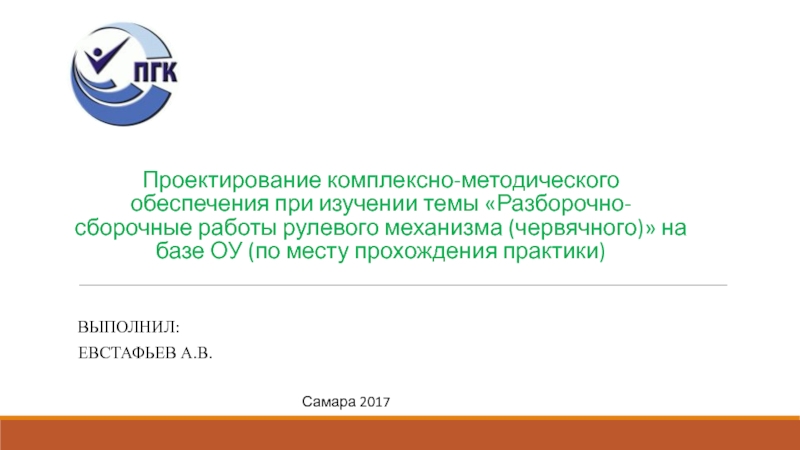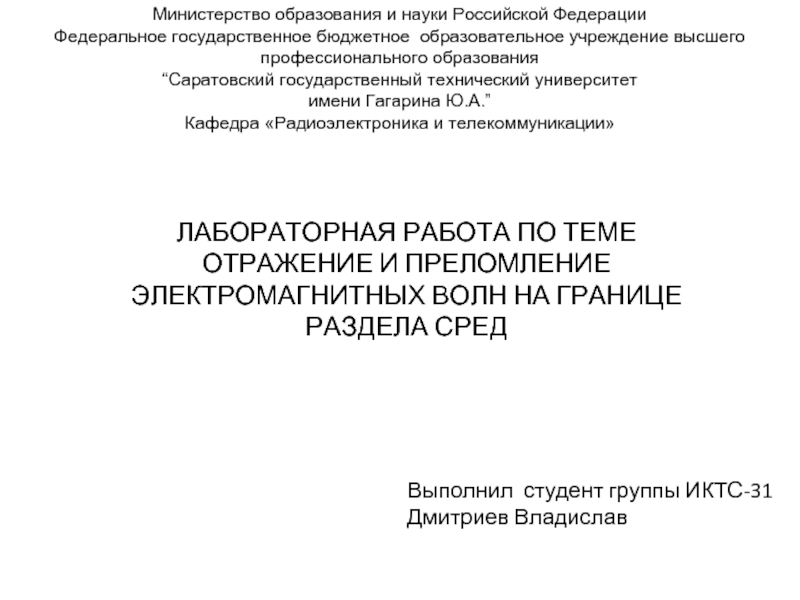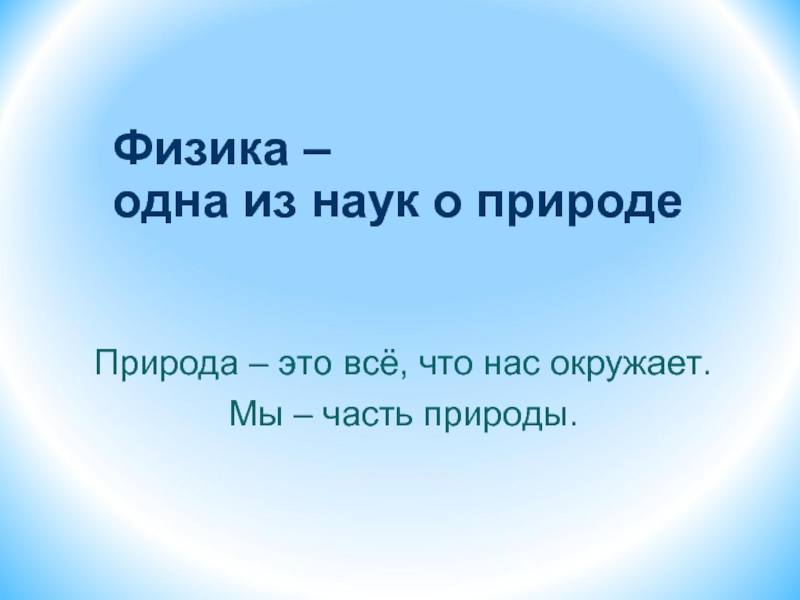- Главная
- Разное
- Дизайн
- Бизнес и предпринимательство
- Аналитика
- Образование
- Развлечения
- Красота и здоровье
- Финансы
- Государство
- Путешествия
- Спорт
- Недвижимость
- Армия
- Графика
- Культурология
- Еда и кулинария
- Лингвистика
- Английский язык
- Астрономия
- Алгебра
- Биология
- География
- Детские презентации
- Информатика
- История
- Литература
- Маркетинг
- Математика
- Медицина
- Менеджмент
- Музыка
- МХК
- Немецкий язык
- ОБЖ
- Обществознание
- Окружающий мир
- Педагогика
- Русский язык
- Технология
- Физика
- Философия
- Химия
- Шаблоны, картинки для презентаций
- Экология
- Экономика
- Юриспруденция
Elementary interactions: hydrophobic & electrostatic; SS and coordinate bonds презентация
Содержание
- 1. Elementary interactions: hydrophobic & electrostatic; SS and coordinate bonds
- 2. Hydrophobic effect Concentration of C6H14
- 3. ENTROPY: SE = kB • ln[ME];
- 5. Experiment: ΔG intA→B= kBT•ln([C1 in A]/[C1 in
- 6. -2/3 +1/3 Loss: S
- 7. High heat capacity d(ΔH)/dT: Melting of “iceberg”
- 8. 20-25 cal/mol per Å2 of molecular accessible non-polar surface Octanol → Water
- 9. Семён Ефимович Бреслер (1911 – 1983) Давид
- 10. ______ large effect _______ small ______ large
- 11. Electrostatics in uniform media: potential
- 12. (1736-1806)
- 13. Water => PROTEIN
- 14. Non-uniform media: εeff = ?
- 15. Non-uniform media: εeff = ?
- 16. Non-uniform media: εeff = ? intermediate dipole
- 17. ϕ = q/ε1r
- 18. - - - - ϕ = (q/ε1)/r
- 19. Good estimate for non-uniform media + -+
- 20. εeffective in non- uniform media 150 40
- 21. Large distance:
- 22. At atomic distances in water:
- 23. Protein engineering experiments: ϕ(r) = ΔpH × 2.3RT ⇒⇒ εeff(r)
- 24. Sir Alan Roy Fersht, 1943 Protein engineering
- 25. Dipole interactions (e.g., H-bonds):
- 26. Electrostatic interactions also occur between charge (q)
- 27. Debye-Hückel screening of electrostatic by ions:
- 28. Electrostatics is T- dependent; U
- 29. S-S bonds (Cys-Cys)
- 30. Coordinate bonds (with Zn++, Fe+++,…) exchange: entropic force
Слайд 1PROTEIN PHYSICS
LECTURES 5-6
Elementary interactions:
hydrophobic
&
electrostatic;
SS and coordinate bonds
Слайд 2Hydrophobic effect
Concentration of C6H14
in H2O:
50 times less
than in
WHY?
H2O
Henry’s constant
(kH,cc)-1 =
for : = 50/1
for ethanol: = 1/47000
[in gas]
[in liquid]
Слайд 3ENTROPY:
SE = kB • ln[ME]; ME=number_of_states(E)
Why kB? What is
Because entropy SE comes to the free energy
FE = E – TSE (measured in energy units) as TSE,
and T is measured in degrees, while
ln[number of states] is dimensionless;
Thus, kB is energy_unit/degree
FREE ENERGY:
Probability(E) ~ ME•exp(-E/kBT) = exp(-FE/kBT)
Boltzmann
F=E-TS at V=const;
G=H-TS=(E+PV)-TS at P=const (better for experiment)
-------------------
Слайд 4 Gint : “Free
(“mean force potential”)
Chemical potential:
μ ≡ G(1) = Gint - T•kBln(V(1)) ≡ Gint + T•kBln[C]
EQUILIBRIUM for transition
of molecule 1 from A to B: GA(1) = GB(1)
chemical potentials in A and B are equal
ΔGintA→B ≡ GintB – GintA
ΔGintA→B= kBT•ln([CinA]/[CinB])
===================================================
Слайд 5Experiment: ΔG intA→B= kBT•ln([C1 in A]/[C1 in B])
ΔSintA→B = -d(ΔGintA→B)/dT
ΔHintA→B =
C6H12
[C] of C6H12
in H2O:
50 times less
than in gas;
100000 times
less than in
liquid C6H12
T=2980K=250C
Слайд 9Семён Ефимович Бреслер
(1911 – 1983)
Давид Львович Талмуд
(1900 - 1973)
Cyrus Homi
Hydrophobic
effect
&
amino acid
water-accessible
surface
Hypothesis on a role of hydrophobic effect in protein folding
Hydrophobic
effect
&
denaturationof proteins
Charles Tanford
(1921 - 2009)
General physical
features of
Hydrophobic
effect
Слайд 11
Electrostatics in uniform media:
potential ϕ1 = q1/εr
Interaction of two
U = ϕ1q2 = ϕ2q1 = q1q2/εr
ε = 1 vacuum
ε ≈ 3 protein
ε ≈ 80 water
Protein/water interface
In non-uniform media: εeff = ?
At atomic distances: εeff = ?
Слайд 13Water => PROTEIN
R ≈ 1.5 - 2 Å
ΔU ≈ +30 - 40 kcal/mol
CHARGE inside PROTEIN:
VERY BAD
CHARGE
inside
PROTEIN
Water => vacuum:
ΔU ≈ +100 kcal/mol
Слайд 19Good estimate for
non-uniform media
+ -+ - +
– + – +
εeff ≈ 150 !!
εeff≈40
ϕ = q/rεeff in positions:
-
- -
-
Слайд 21Large distance:
εeff = ε = 80 εeff = ?
intermediate
“vacuum”, ε ~ 1?
but the absence
of intermediate
dipoles can
only increase
interaction…
Слайд 22At atomic distances in water:
1) ε=80 is not
(salt does not dissolve, if ε<50 at 3Å!)
[H]1/2=10-1.75 [H]1/2=10-4.25=10-1.75 × e-ΔGel/RT
ε ≈ 30-40 at ≈ 2.5Å!
ΔGel = 2.5 × ln(10) × RT ≈ 6RT ≈ 3.5 kcal/mol at ≈2.5Å
Слайд 25Dipole interactions
(e.g., H-bonds):
(HO)-1/3-H+1/3::::::(OH)-1/3-H+1/3
Quadruple interactions
Also: charge-dipole, dipole-quadruple, etc.
Potentials:
Слайд 26Electrostatic interactions also occur between charge (q) and non-charged body, if
U ~ q • [1/ε2 – 1/ε1] • [ε2 /(ε1+ε2 /2)] • V • (1/r 4) at large r
In water: repulsion of charges from non-polar molecules (since here ε1>>ε2);
in vacuum (where ε1<ε2) : just the opposite!
+
+
+
-
-
-
ε2
V
ε1
Слайд 27Debye-Hückel screening
of electrostatic by ions:
U = [q1q2/εr]•exp(-r/D) ;
Ionic strength I = ½ΣiCi(Ziion)2 .
Usually: I ≈ 0.1 [mol/liter]; D ≈ 8Å.
Electrostatics is an example of a multi-body
(charge1, charge2, media, ions) interaction
Слайд 28
Electrostatics is T- dependent;
U = (1/ε)•(q1q2/r)
is free energy (U = H-TS);
TS
= [dln(ε)/dlnT]•U
in water: when T grows from 273o to 293oK (by 7%),
ε decreases from 88 to 80 (by 10%):
-TS ≈ 1.3 U; H ≈ -0.3 U
In water the entropic term (-TS) is the main
for electrostatics!
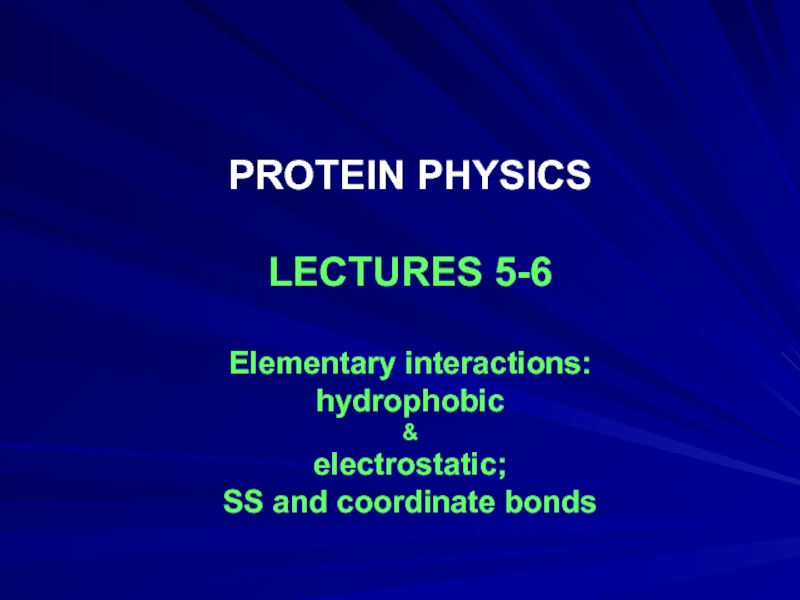

![ENTROPY:SE = kB • ln[ME]; ME=number_of_states(E)Why kB? What is kB?Because entropy SE comes to](/img/tmb/5/411250/672e701e365f22b7f9388540370694cc-800x.jpg)
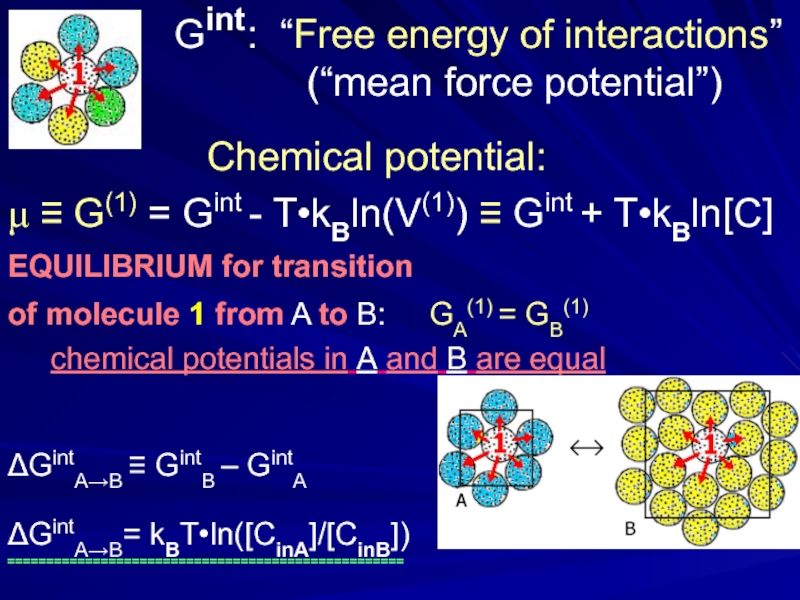
![Experiment: ΔG intA→B= kBT•ln([C1 in A]/[C1 in B])ΔSintA→B = -d(ΔGintA→B)/dTΔHintA→B = ΔGintA→B +TΔSintA→B C6H12[C] of](/img/tmb/5/411250/39e0173bf0460d7d10ba7bf5cebc34ac-800x.jpg)
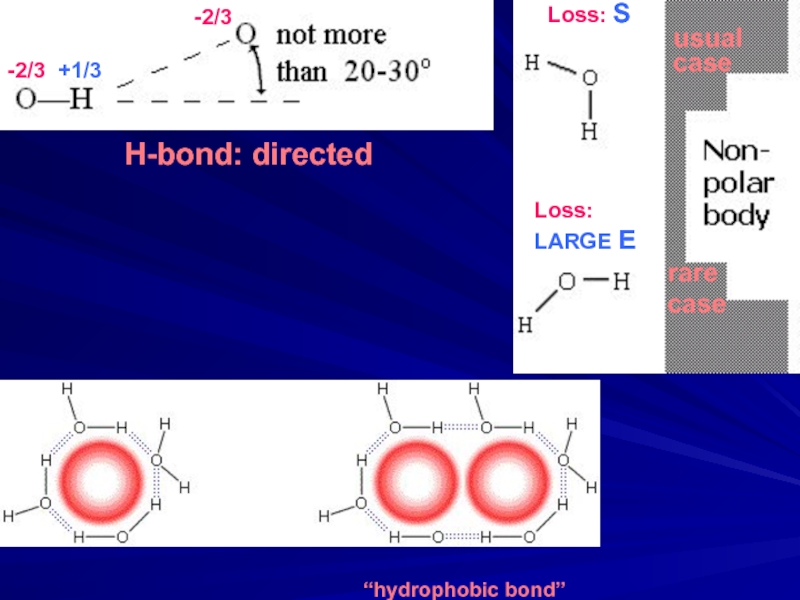
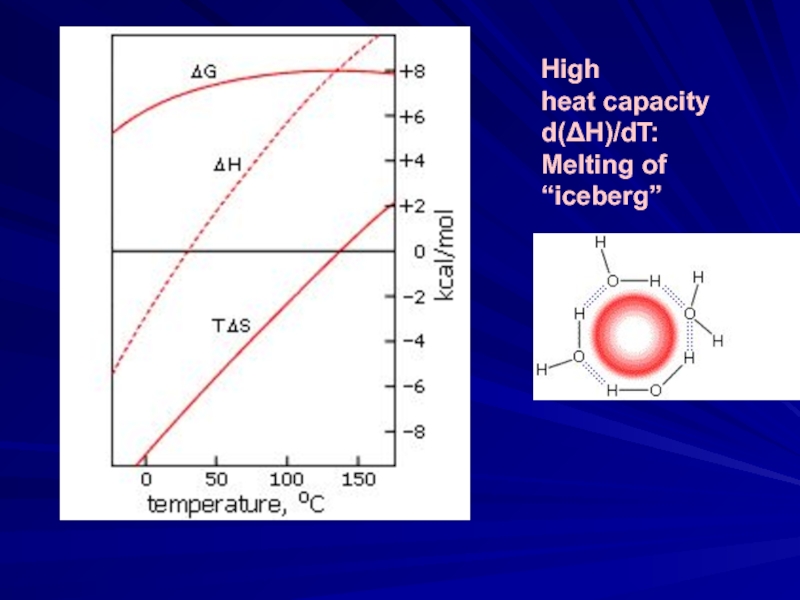
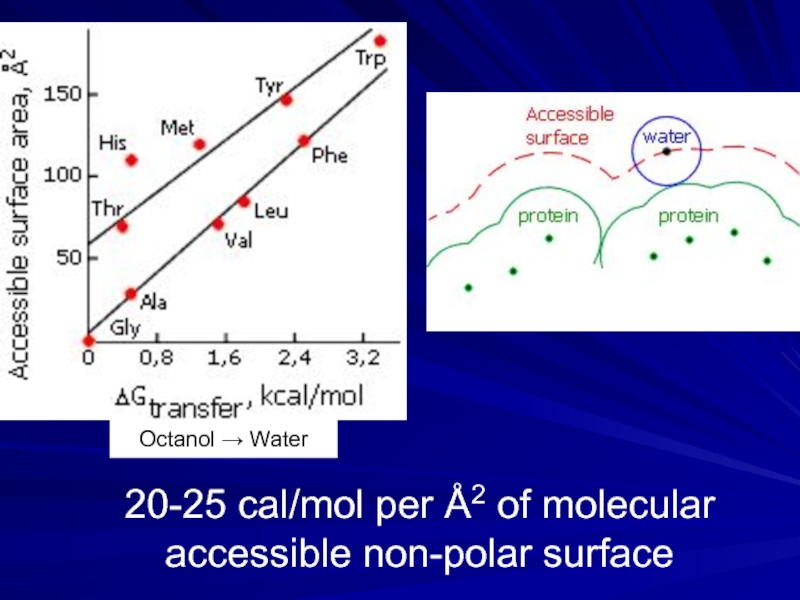

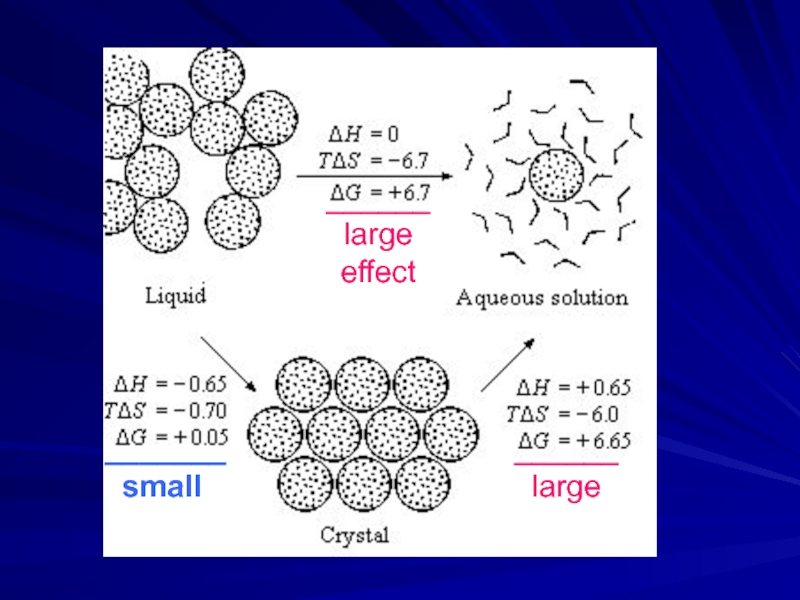
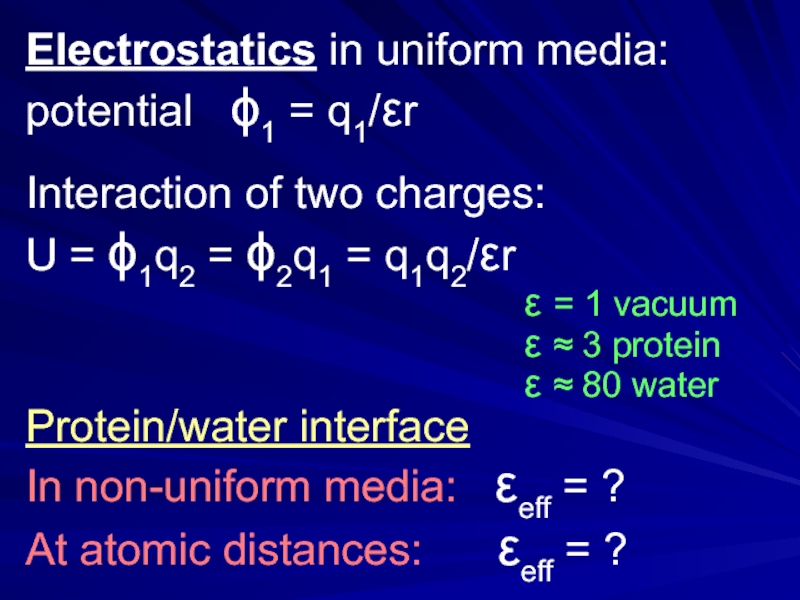
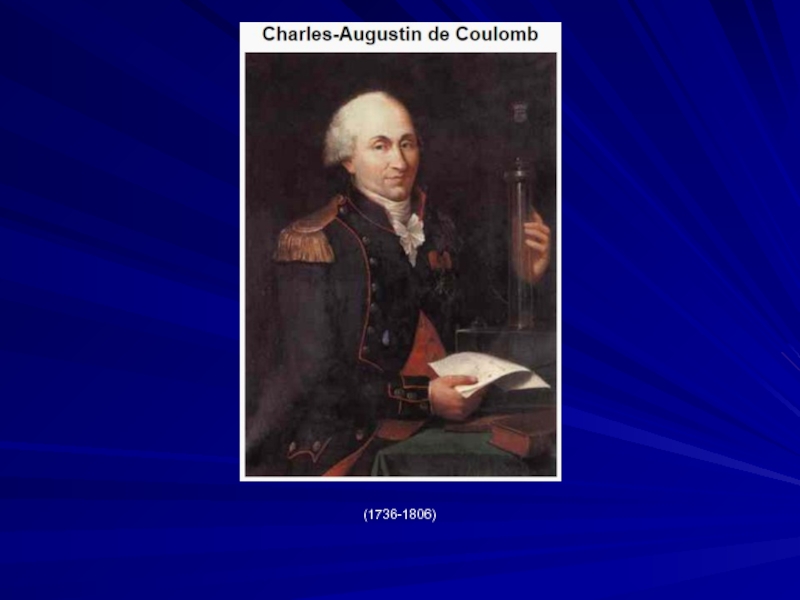
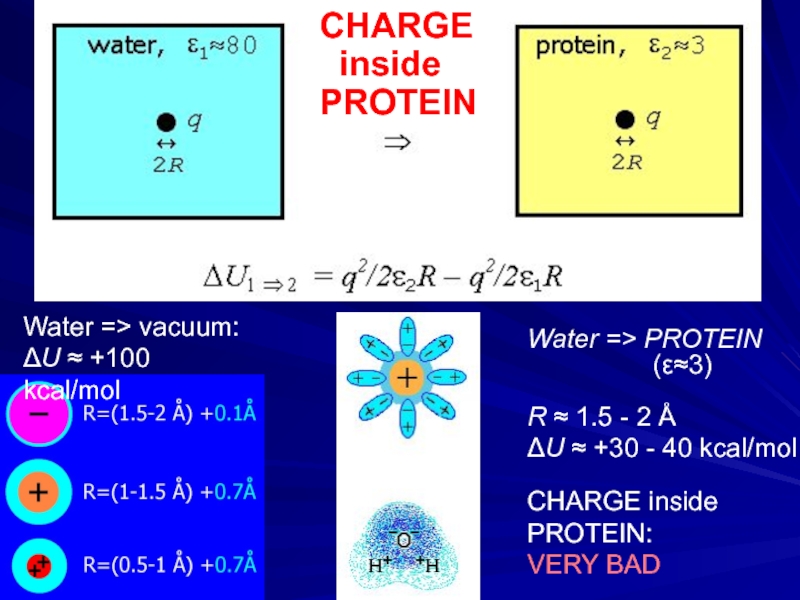
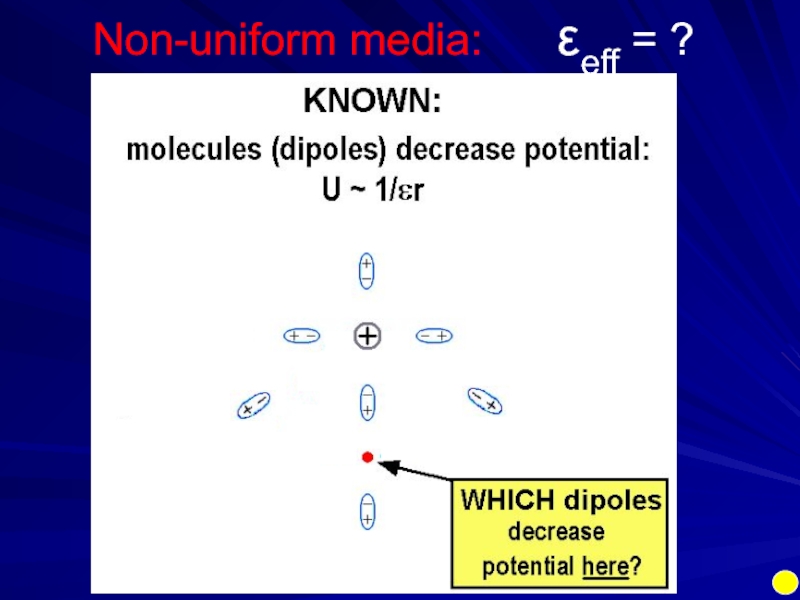

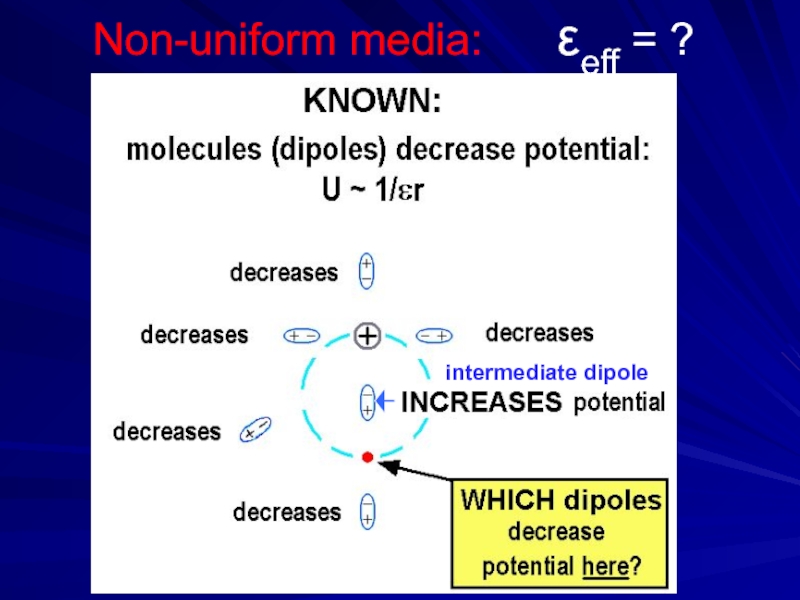
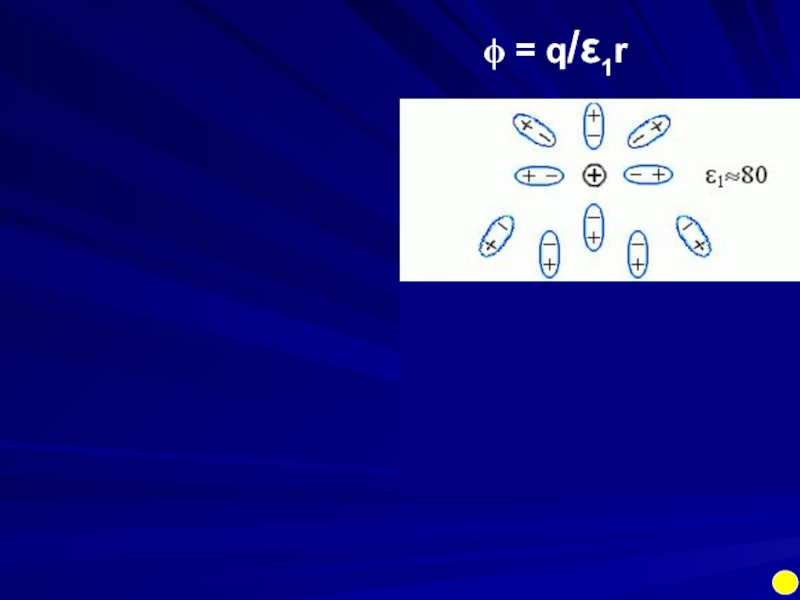

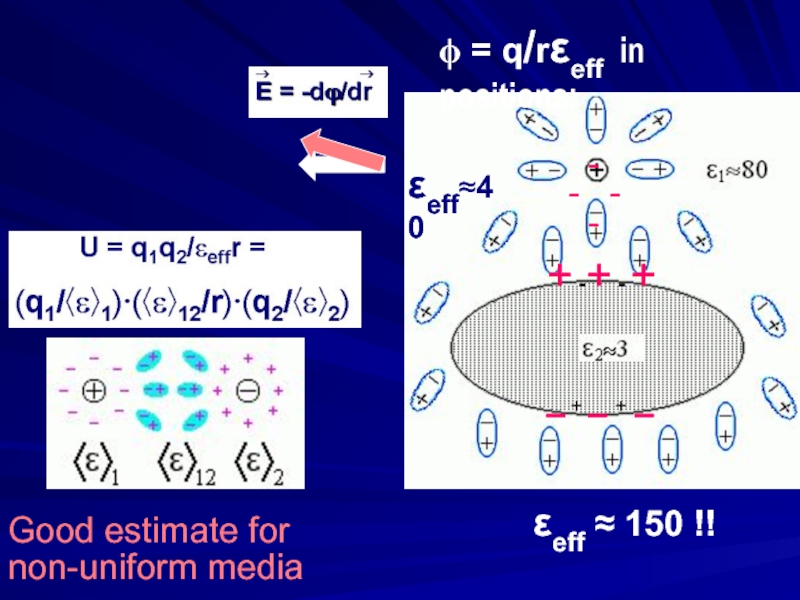
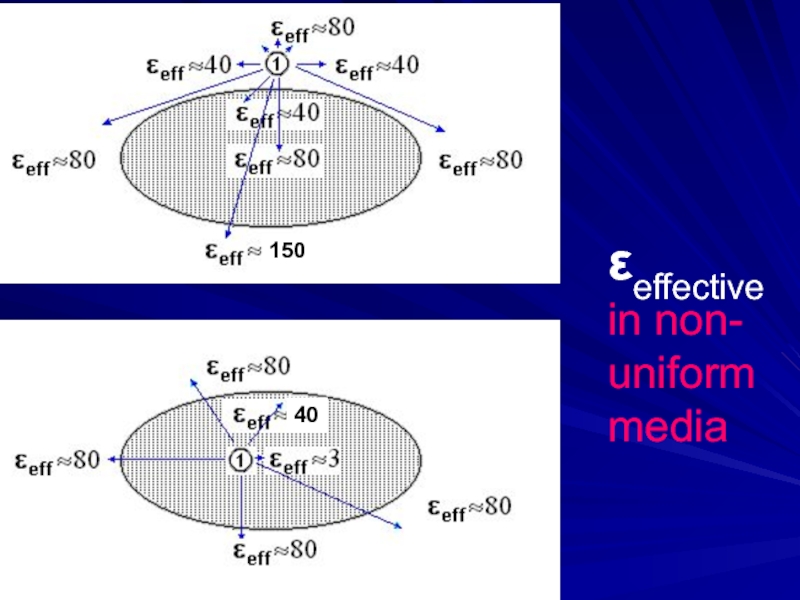
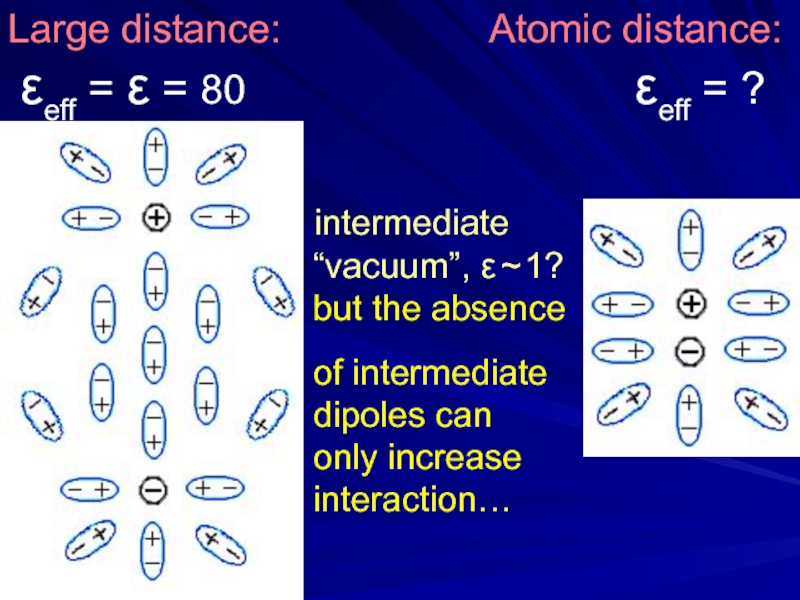
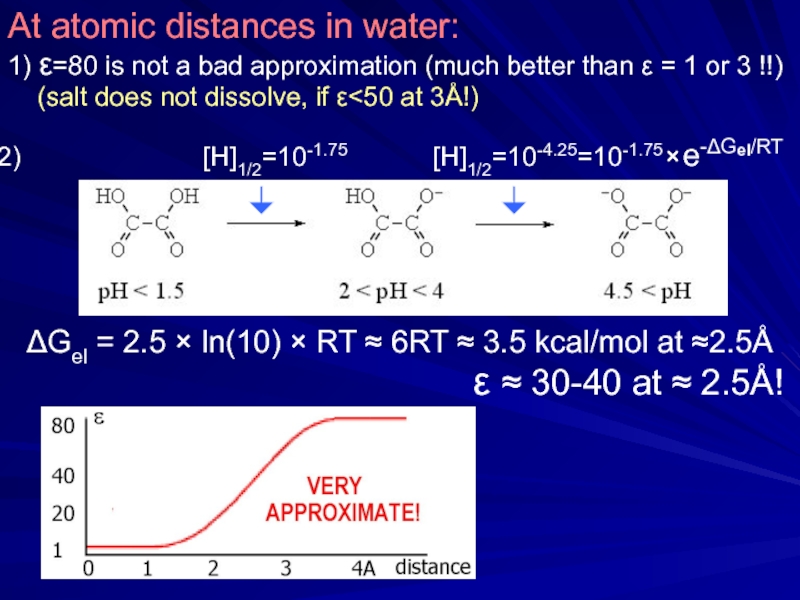

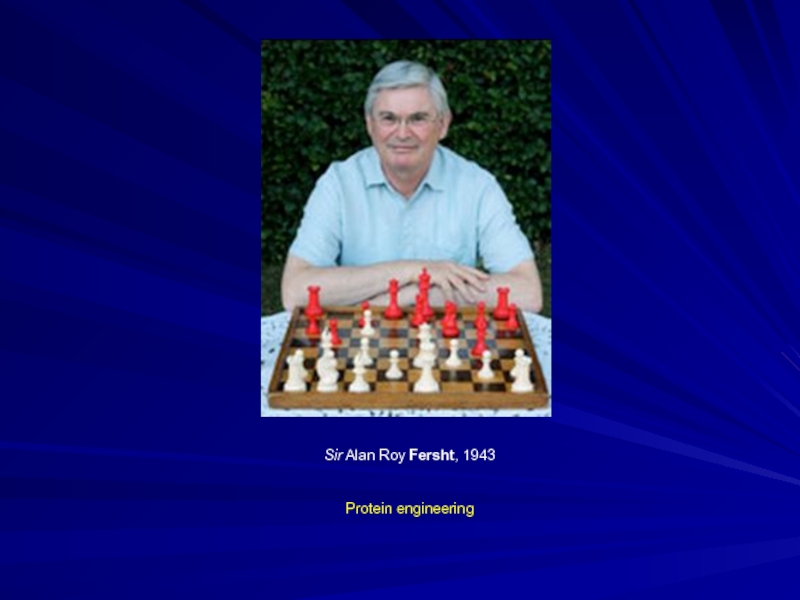

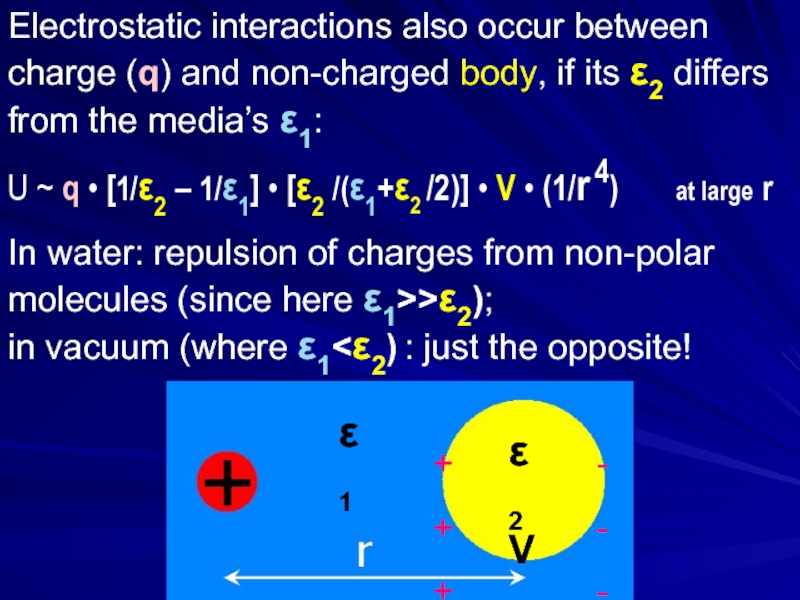
![Debye-Hückel screening of electrostatic by ions:U = [q1q2/εr]•exp(-r/D) ;](/img/tmb/5/411250/6914c30d0f7a588de9539bd173722d5c-800x.jpg)
